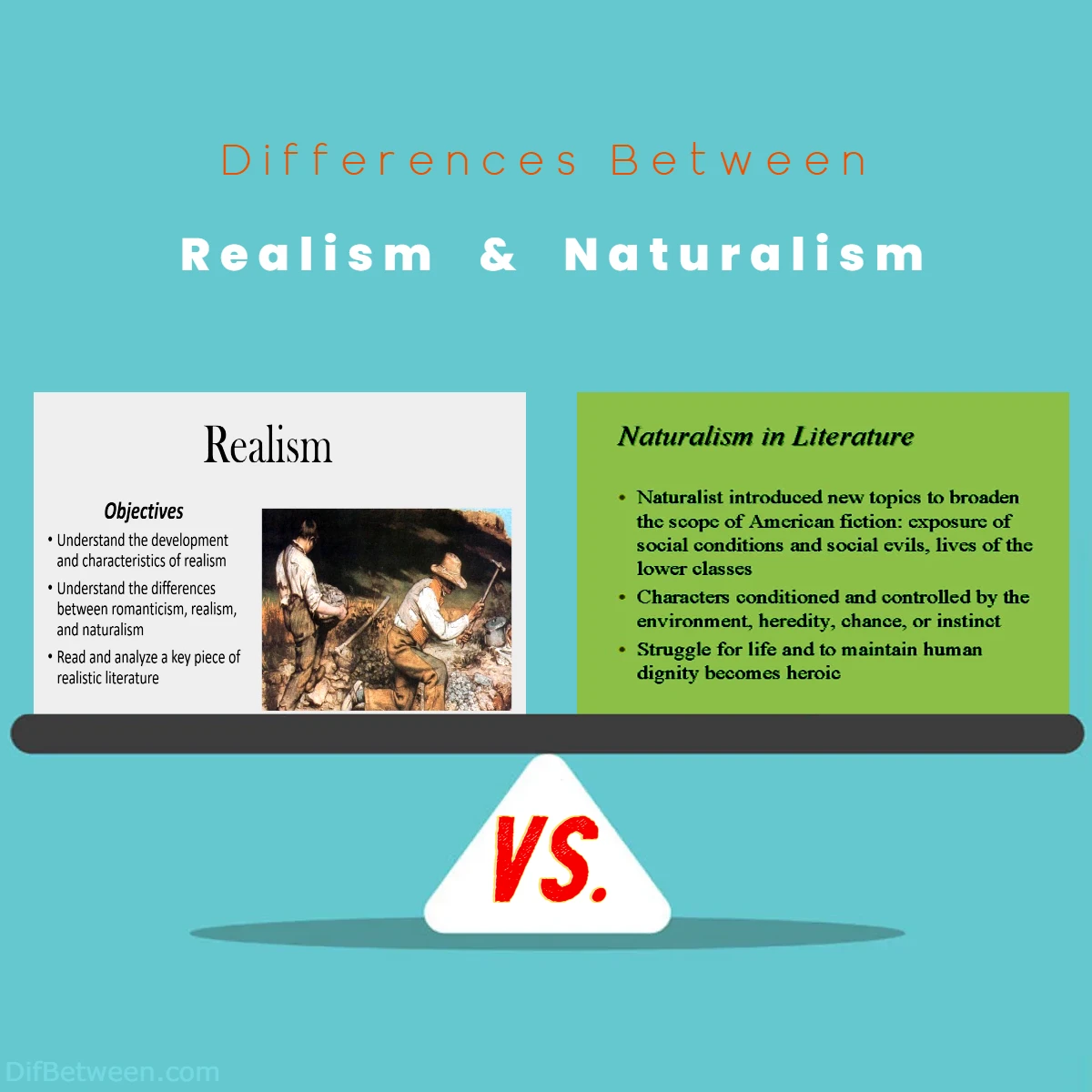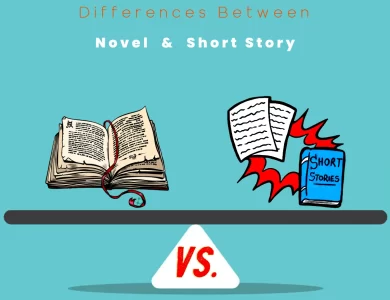
| Aspect | Realism | Naturalism |
|---|---|---|
| Philosophical Basis | Objectivity and a rejection of romanticism or idealization | Determinism, influenced by biology, environment, and heredity |
| Treatment of Characters | Multi-dimensional, with inner thoughts and motivations | Characters often shaped by external forces, less agency |
| Themes and Subject Matter | Middle-class life, social fabric, everyday struggles | Darker themes: poverty, addiction, crime, survival |
| Narrative Style and Tone | Straightforward, objective, various tones | Clinical, detached, often pessimistic tone |
| Artistic Goals | Faithful representation of reality | Analytical, social commentary |
| Origins and Influences | Emerged in France during the mid-19th century as a reaction to Romanticism | Evolved from Realism, founded by Émile Zola, influenced by scientific thought |
| Notable Authors and Works | Gustave Flaubert (“Madame Bovary”), Honoré de Balzac (“La Comédie Humaine”), Leo Tolstoy (“War and Peace”) | Émile Zola (“Germinal”), Stephen Crane (“The Red Badge of Courage”), Theodore Dreiser (“Sister Carrie”) |
| Literary Techniques | Detailed Description, Psychological Insight, Realistic Dialogue | Determinism, Objective Narration, Societal Critique |
| Famous Works | “Madame Bovary,” “Anna Karenina” | “Germinal,” “The Call of the Wild” |
In the world of storytelling, where words weave magic and characters come to life, the choice between Realism and Naturalism can be akin to selecting a path in a literary forest. Each path leads to unique destinations, offering a different lens through which to view the human experience.
Differences Between Realism and Naturalism
The main differences between Realism and Naturalism lie in their philosophical foundations and narrative approaches. Realism, as a literary movement, seeks to portray everyday life with objectivity, avoiding idealization. Characters in Realist works are multi-dimensional, and the emphasis is on their inner thoughts and motivations. On the other hand, Naturalism extends this concept by delving into the deterministic forces shaping human behavior, such as biology, heredity, and environment. Naturalist literature often takes on darker themes, emphasizing the harsh realities of life and the limited agency of its characters. In summary, while both movements focus on portraying reality, Realism offers a more balanced and character-driven perspective, whereas Naturalism delves deeper into the influences that shape human destinies, often resulting in a more pessimistic tone.
Definition and Overview
Realism and Naturalism are both literary movements that emerged in the 19th century, primarily in Europe and the United States. They are reactions against the Romantic movement, which emphasized emotion, imagination, and idealism. Let’s start by defining each of these movements:
Realism
Realism is a literary and artistic movement that seeks to depict everyday life and society as it truly is, without idealizing or romanticizing it. Realist works often focus on the ordinary, the mundane, and the lives of common people. Realist authors aim to provide an accurate representation of their characters and settings, and they tend to avoid melodrama and sensationalism.
In the realm of literature, Realism is associated with authors like Gustave Flaubert, Honore de Balzac, and Leo Tolstoy. These writers are known for their detailed character studies and their commitment to portraying social realities, including class distinctions, morality, and the struggles of ordinary individuals.
Naturalism
Naturalism, on the other hand, is an extension of Realism. It takes the idea of portraying life as it is a step further by emphasizing the role of environment and heredity in shaping human behavior and destiny. Naturalist works often delve into the darker aspects of life, including poverty, crime, and the harsh realities of existence. In Naturalism, characters are often depicted as being at the mercy of their surroundings and biological predispositions.
Prominent Naturalist authors include Émile Zola, Stephen Crane, and Theodore Dreiser. Their works tend to explore themes of determinism, survival, and the impact of societal forces on individual lives.
Key Differences
Now that we have a foundational understanding of Realism and Naturalism, let’s delve into their key differences:
Philosophical Underpinnings
Realism is rooted in the belief that the world can be observed objectively and described without the need for romanticism or idealization. Realist authors aim to capture the surface of reality, portraying events and characters as they appear in everyday life. While Realism acknowledges the influence of society on individuals, it does not delve deeply into the deterministic forces that shape human behavior.
Naturalism, on the other hand, is heavily influenced by the deterministic philosophy of thinkers like Charles Darwin and Sigmund Freud. Naturalist authors believe that human behavior is largely determined by biological, environmental, and social factors. They explore the darker and grittier aspects of life, often depicting characters who are trapped by their circumstances and heredity. In Naturalism, the individual is seen as a product of these forces, and free will is limited.
Treatment of Characters
In Realism, characters are typically well-rounded and multi-dimensional. Authors invest time in developing their personalities, motivations, and inner thoughts. Realist literature often provides readers with a deep understanding of the characters’ lives, choices, and dilemmas. These characters can evolve and change throughout the narrative, reflecting the complexities of real-life individuals.
In contrast, Naturalism tends to feature characters who are more like products of their environment and biology. They may be depicted as having limited agency in shaping their destinies. Naturalist authors often emphasize the impact of external factors, such as poverty or social class, on their characters’ lives. These characters may not undergo significant personal growth or transformation, as their fates are often sealed by their circumstances.
Themes and Subject Matter
While both Realism and Naturalism focus on depicting everyday life, their choice of themes and subject matter differs:
- Realism often explores themes related to middle-class life, morality, and the social fabric of society. It may depict the struggles and aspirations of ordinary people, but it tends to avoid extreme or sensationalistic subjects.
- Naturalism, in contrast, gravitates towards the darker and more controversial aspects of existence. It delves into themes such as poverty, addiction, crime, and the brutal realities of survival. Naturalist literature is more likely to confront the harsh truths of life, often with a sense of pessimism.
Narrative Style and Tone
The narrative style and tone in Realism and Naturalism also differ:
- Realist works tend to have a straightforward and objective narrative style. Authors aim for clarity and accuracy in their descriptions. The tone can vary but is often more balanced and optimistic, reflecting a belief in the potential for individual growth and improvement.
- Naturalist literature may employ a more clinical and detached narrative style. Authors may use scientific language and focus on describing events and characters in a dispassionate manner. The tone in Naturalism is often darker and more pessimistic, emphasizing the powerlessness of individuals in the face of deterministic forces.
Artistic Goals
Realism primarily seeks to provide an accurate and faithful representation of reality. Realist authors aim to capture the nuances of everyday life and human experiences. Their goal is to offer readers a mirror to the world, allowing them to recognize and relate to the characters and situations depicted in the narrative.
Naturalism, on the other hand, has a more critical and analytical approach. Naturalist authors are interested in exploring the underlying causes and influences that shape human behavior. They use literature as a means of social commentary, often highlighting the harsh conditions faced by marginalized individuals.
A Comparison Table
To summarize the key differences between Realism and Naturalism, let’s take a closer look at their distinct characteristics in a comparison table:
| Aspect | Realism | Naturalism |
|---|---|---|
| Philosophical Basis | Objectivity and a rejection of romanticism or idealization | Determinism, influenced by biology, environment, and heredity |
| Treatment of Characters | Multi-dimensional, with inner thoughts and motivations | Characters often shaped by external forces, less agency |
| Themes and Subject Matter | Middle-class life, social fabric, everyday struggles | Darker themes: poverty, addiction, crime, survival |
| Narrative Style and Tone | Straightforward, objective, various tones | Clinical, detached, often pessimistic tone |
| Artistic Goals | Faithful representation of reality | Analytical, social commentary |
Origins and Influences
Realism and Naturalism both emerged in the 19th century as reactions to the Romantic movement. Here’s a closer look at their origins and influences:
Realism
- Origins: Realism found its roots in France during the mid-19th century. It was partly a reaction to the idealized and emotionally charged narratives of Romanticism. Authors like Gustave Flaubert, known for “Madame Bovary,” and Honoré de Balzac played pivotal roles in the development of Realism.
- Influences: Realism drew inspiration from the rise of photography and the desire to capture life as it truly was. The realist painters of the time, such as Gustave Courbet, also influenced the movement by portraying scenes from everyday life with accuracy.
Naturalism
- Origins: Naturalism can be seen as an extension of Realism and had its heyday in the late 19th century. Émile Zola, a French novelist, is often regarded as the founder of Naturalism. His work, “Thérèse Raquin,” is a classic example of the movement.
- Influences: Naturalism was heavily influenced by scientific thought, particularly the ideas of Charles Darwin and his theory of evolution. Naturalists believed that human behavior could be studied and explained in much the same way as natural phenomena.
Notable Authors and Their Works
Let’s take a closer look at some of the most notable authors associated with Realism and Naturalism, along with their famous literary works:
Realism
- Gustave Flaubert:
- Famous Work: “Madame Bovary” (1857) – A novel that explores the life of Emma Bovary, a provincial woman who yearns for a more glamorous and exciting existence.
- Honoré de Balzac:
- Famous Work: “La Comédie Humaine” (1830-1857) – A vast series of interconnected novels and stories that depict French society during the 19th century, with a focus on social classes and individuals’ aspirations.
- Leo Tolstoy:
- Famous Work: “War and Peace” (1869) – A sprawling epic that delves into the lives of Russian aristocrats during the Napoleonic era, exploring themes of love, war, and destiny.
Naturalism
- Émile Zola:
- Famous Work: “Germinal” (1885) – This novel takes place in the coal mining communities of France and explores the harsh conditions endured by the working class. It vividly depicts the struggles of the miners.
- Stephen Crane:
- Famous Work: “The Red Badge of Courage” (1895) – A novel set during the American Civil War, it follows the psychological journey of a young soldier named Henry Fleming.
- Theodore Dreiser:
- Famous Work: “Sister Carrie” (1900) – This novel tells the story of Carrie Meeber, a young woman who moves to Chicago in pursuit of a better life. It explores themes of ambition and materialism.
Literary Techniques
Both Realism and Naturalism employ specific literary techniques to achieve their respective goals:
Realism
- Detailed Description: Realist authors provide meticulous descriptions of settings, characters, and social contexts to create a vivid and accurate portrayal of everyday life.
- Psychological Insight: Realism often delves into the inner thoughts and emotions of characters, offering readers a deep understanding of their motivations and conflicts.
- Dialogue: Realist dialogues are reflective of natural speech patterns and are used to reveal character traits and societal norms.
Naturalism
- Determinism: Naturalist literature emphasizes the deterministic forces shaping characters’ lives. Authors highlight the influence of heredity, environment, and external factors.
- Objective Narration: Naturalist writing can have a detached, almost scientific tone, presenting events and characters objectively, as if conducting an experiment.
- Societal Critique: Naturalism often serves as a platform for critiquing society and its treatment of individuals who are at the mercy of their circumstances.
Famous Works
To illustrate the differences between these two literary movements further, let’s explore some iconic works from each:
Realism
- “Madame Bovary” by Gustave Flaubert: This novel follows the life of Emma Bovary, a provincial woman who becomes disillusioned with her marriage and seeks fulfillment through extramarital affairs and extravagant spending. Flaubert’s meticulous attention to detail and exploration of Emma’s psychology exemplify Realism.
- “Anna Karenina” by Leo Tolstoy: Tolstoy’s masterpiece tells the story of Anna Karenina, a woman trapped in a loveless marriage. The novel provides a panoramic view of Russian society, portraying its complexities and class divisions with remarkable realism.
Naturalism
- “Germinal” by Émile Zola: In “Germinal,” Zola vividly portrays the harsh conditions endured by coal miners in 19th-century France. The characters in the novel are depicted as products of their environment, with their destinies shaped by the oppressive coal mines.
- “The Call of the Wild” by Jack London: Although primarily associated with American literature, London’s work often exhibits naturalistic elements. “The Call of the Wild” follows the journey of a domestic dog, Buck, as he reverts to a more primitive state in the wild, highlighting the role of environment and instincts.
Realism or Naturalism : Which One is Right Choose for You?
Choosing between Realism and Naturalism in literature largely depends on your personal preferences as a reader and what themes and styles resonate with you. Each of these literary movements offers a distinct perspective on the human experience, and the right choice for you depends on your interests and what you seek in a reading experience.
Let’s explore some factors to consider when deciding which literary movement may be the right fit for you:
Realism: When to Choose It?
- You Appreciate Everyday Life: If you enjoy stories that focus on the ordinary and the mundane aspects of life, Realism is a good choice. Realist literature excels at capturing the nuances of daily existence and the complexities of human relationships.
- Character Development Matters: Realism often features well-rounded and multi-dimensional characters with intricate inner lives. If you prefer narratives that delve deep into character psychology and personal growth, Realism is a strong option.
- You Seek a Balanced Perspective: Realist works tend to provide a balanced view of life, showcasing both its joys and struggles. If you appreciate narratives that offer a mix of optimism and realism, Realism is a suitable choice.
- Social Commentary Interests You: Realism often explores societal norms, class distinctions, and moral dilemmas. If you’re interested in literature that offers insightful commentary on social issues and human behavior, Realism provides a platform for such exploration.
Naturalism: When to Choose It?
- You Prefer Darker, Grittier Themes: Naturalism is known for its exploration of harsh and often pessimistic themes, such as poverty, survival, and the impact of environment on individuals. If you are drawn to narratives that confront the darker aspects of life, Naturalism may be more appealing.
- You’re Interested in Determinism: Naturalism places a strong emphasis on the deterministic forces that shape human behavior. If you find the idea of characters being products of biology, heredity, and environment intriguing, Naturalism offers a unique perspective.
- You Like Objective Narration: Naturalist literature often employs a detached, scientific style of narration. If you appreciate stories told with an objective tone, as if observing characters and events from a distance, Naturalism aligns with this approach.
- Societal Critique Appeals to You: Naturalism frequently serves as a platform for critiquing society and highlighting the impact of external forces on individuals. If you’re interested in literature that challenges societal norms and offers a critical perspective, Naturalism can be a compelling choice.
Ultimately, there is no “right” or “wrong” choice between Realism and Naturalism. Both movements have made significant contributions to the world of literature and offer valuable insights into the human condition. Your choice may also vary depending on your mood and reading preferences at a given time. Exploring both Realism and Naturalism can provide a well-rounded literary experience and a deeper understanding of the diversity within the world of literature.
FAQs
Realism is a literary movement that aims to depict everyday life and society as it truly is, without idealization. It emphasizes accurate representation of characters and settings and avoids melodrama or sensationalism.
Naturalism is an extension of Realism that explores the role of environment and heredity in shaping human behavior and destiny. It often delves into darker themes and portrays characters as products of their surroundings and biology.
Realism features well-rounded, multi-dimensional characters with detailed inner lives. Naturalism, in contrast, often depicts characters as being heavily influenced by external forces, with limited agency.
Realism focuses on middle-class life, social fabric, and everyday struggles. Naturalism delves into darker themes like poverty, addiction, crime, and survival.
Realism uses a straightforward, objective narrative style with various tones. Naturalism tends to be more clinical and detached, often with a pessimistic tone.
Realism is associated with authors like Gustave Flaubert, Honoré de Balzac, and Leo Tolstoy. Naturalism is linked to Émile Zola, Stephen Crane, and Theodore Dreiser.
Realism aims to provide a faithful representation of reality, while Naturalism seeks to offer an analytical exploration of societal forces and determinism.
Realism emerged in mid-19th century France as a reaction to Romanticism. Naturalism evolved from Realism and was founded by Émile Zola, influenced by scientific thought.
Yes, notable Realist works include “Madame Bovary” and “Anna Karenina,” while famous Naturalist works include “Germinal” and “The Call of the Wild.”
Your choice depends on your preferences. If you enjoy everyday life and character development, Realism may be your preference. If you prefer darker themes and an exploration of determinism, Naturalism might be more appealing.
Read More:
Contents






